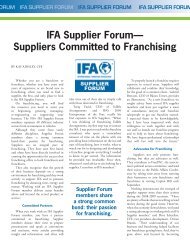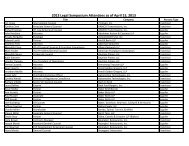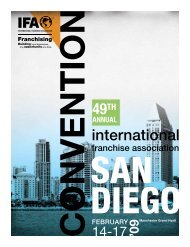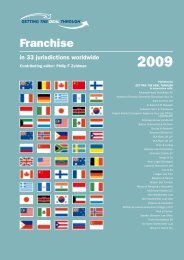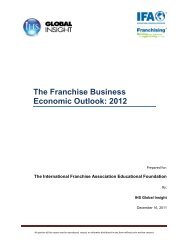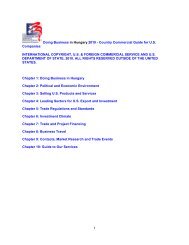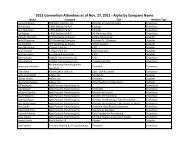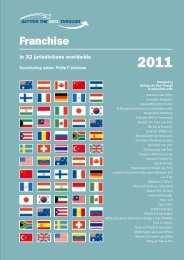South Africa - International Franchise Association
South Africa - International Franchise Association
South Africa - International Franchise Association
Create successful ePaper yourself
Turn your PDF publications into a flip-book with our unique Google optimized e-Paper software.
electricity producers in the world. <strong>South</strong> <strong>Africa</strong>’s rapid economic growth in recent years<br />
has resulted in electricity demand rising faster than anticipated. In 2009, however, the<br />
global economic crisis meant the country’s power supply constraints were temporarily<br />
eased, as demand for electricity fell on the back of declining global economic activity. As<br />
the world emerged from the global crisis in 2010, and electricity demand in the country<br />
started trending upwards again, it became apparent that the brief reprieve from the<br />
global slowdown created a false sense of electricity supply security.<br />
Electricity supply constraints are expected to remain a feature of <strong>South</strong> <strong>Africa</strong>’s social<br />
and economic landscape for several years to come, and the introduction of additional<br />
capacity will be required for at least the next 20 years.<br />
To assist with the planning for this new capacity, government has produced The Policy-<br />
Adjusted Integrated Resource Plan (IRP2010), approved in 2011, which will be<br />
continuously revised and updated.<br />
IRP2010 outlines the proposed electricity generation capacity mix for <strong>South</strong> <strong>Africa</strong> for the<br />
period 2010 to 2030, and expects that this will be delivered through a range of projects<br />
that will be implemented by Eskom and the public sector (accounting for 70% of the<br />
capacity) and various independent power producers (IPPs) (accounting for the remaining<br />
30% of the capacity). The plan also factors in demand savings over the period, to be<br />
achieved through energy efficiency and demand side management (DSM) strategies.<br />
Additional Generation Capacity<br />
Eskom is to play a key role in achieving the objectives outlined in IRP2010 and the utility<br />
is currently pursuing a suite of capacity-expansion projects valued in the range of $69.83<br />
billion (R500-billion). These projects, which will bring more than 11 000 MW of additional<br />
power on stream by 2020, form part of what the IRP2010 refers to as ‘committed build’.<br />
Key among the projects currently under development by Eskom are the return to service<br />
projects, which will bring previously decommissioned capacity back into production; the<br />
Medupi and Kusile projects, which will introduce significant new coal-fired baseload<br />
capacity to the country’s power system; and the Ingula pumped-storage project, which<br />
will introduce additional peaking capacity.<br />
There are also two renewable power projects currently under development by the utility<br />
– the Sere wind power project and the Upington concentrating solar thermal power<br />
project.<br />
Funding<br />
Securing funding has been challenging for the utility, and it was only in 2010, when<br />
government announced its equity injection, that Eskom was confident that it would be<br />
able to proceed as planned with all the projects and contracts to which it was committed.<br />
The National Energy Regulator of <strong>South</strong> <strong>Africa</strong> (NERSA) approved Eskom’s tariff<br />
increase application of 24.8% from April 1, 2010, and subsequent increases of 25.8%<br />
and 25.9% for 2011/12 and 2012/13 respectively. Eskom’s finance director has indicated<br />
that the utility could request two further increases in the range of 25% a year in 2013/14<br />
and 2014/15.





